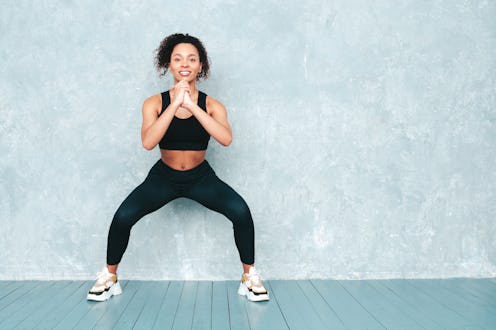Fitness
Why Trainers Recommend Compound Strength Training
Get more out of your sweat sessions.

If you’ve ever done a lunge, squat, or even a burpee, then you’ve already experienced a strength training compound exercise. These moves are really great for your fitness game because they engage multiple muscle groups at once. (Hint: This is also why they always seem so hard.)
As an example, think of the standard squat. “A squat is a compound exercise because it works the quads, glutes, hamstrings, calves, and even the core and back at the same time,” says certified personal trainer Larissa Nicole. Compare that to an isolation exercise, like a bicep curl that only targets the bicep, and you can see why a compound exercise might give you more bang for your buck.
If your goal is to get stronger overall, these slightly-more-complicated moves are an efficient way to go. Training multiple muscles at the same time makes a workout more challenging and expends more energy, Nicole says. This also means you get more of an elevated heart rate compared to isolation exercises. It also puts more “load” or stress on your body, all of which can help you get stronger faster.
Compound strength exercises count as functional training, too, because they work the muscles that help you in everyday movements. “If you were to lift a heavy suitcase, for example, you'd be working multiple muscle groups to squat down and pick up the suitcase and then stand and lift it,” Nicole explains. “So, training through compound movements can help with preventing injury, strengthening those muscle groups, and making movement easier overall.”
Thomas Roe, an ACE-certified personal trainer, says compound exercises also target both primary and secondary muscles at the same time, meaning multiple muscle groups have to work in unison to perform each move. And that’s beneficial for your body’s overall mobility.
Roe recommends doing compound exercises like the ones listed below two to three days a week, depending on your goals, along with two to three days of cardio to create a balanced fitness routine.
How To Do Strength Training Compound Exercises
Here, trainers share how to do some of the most common compound exercises. Add them to a strength training routine to ensure you’ve covered all your bases.
1. Goblet Squats
This type of squat helps support functional movements by improving hip mobility and supporting the quads, glute, core, back, and hamstrings, says Nicole.
- Stand with your feet hip-width apart.
- Hold a dumbbell or kettlebell upside down, AKA “goblet style,” Nicole explains.
- Slowly lower your body down into a squat position.
- Keep chest high, ribs tucked in. Create a 90-degree angle with legs.
- At the bottom of squat, push feet into ground, exhale, and stand back up.
- Keep the weight close to the chest the whole time.
- Do as many reps as you can while maintaining good form.
2. Dumbbell Squat Curl To Press
“This compound exercise works a lot of your major muscle groups, including the glutes, biceps, traps, shoulders, hip flexors, hamstrings, quads, and calves,” says NASM-certified personal trainer Marnie Kunz.
- Start with feet hip-width apart, toes pointed forward.
- Hold dumbbells by your side.
- Squat down to comfortable position, then return to stand.
- Do a bicep curl, rotate palms toward shoulders, and bring weights up to shoulders.
- Press dumbbells straight up overhead, rotating hands forward until arms are extended.
- Reverse and bring dumbbells back down in the same pattern.
- Maintain a tight core, straight back.
3. Push-ups
According to Roe, this simple move targets your chest and pecs (the primary muscles worked) as well as your triceps, which are the secondary muscles.
- Place your hands on the floor alongside your chest, legs extended straight behind you.
- Press hands into the floor to lift your whole body up.
- Lower back down with control.
- To modify, keep your knees on the ground.
- Aim for 3 sets of 10 reps.
4. Reverse Lunges
According to certified personal trainer Erin Mahoney, a reverse lunge will improve your lower body strength, function, and balance since you’re working both legs.
- Shift weight to right foot.
- Step back with left foot.
- As left foot steps back and plants, allow upper body to tip forward slightly.
- Back foot has elevated heel.
- Keep hips square.
- Lower body toward ground, weight in front heel.
- Engage glutes to drive back up to stand.
- Do 4 to 6 reps, 2 to 3 sets per leg with three minutes of rest in between.
5. Burpees
Burpees are one of the most hated exercises for a reason, Roe says. They’re an exhausting combo of bodyweight exercises that hit everything from the glutes and quads to the core and shoulders, while also elevating your heart rate — but that’s why they're so beneficial.
- Jump straight up, an inch or so off the floor.
- As you land, squat to place hands on ground.
- Jump feet back behind you into a high plank.
- Perform a push-up.
- Hop both feet forward again.
- Jump back into the air.
- Do 5 burpees, then rest for 10 seconds.
- Do 10 burpees, then rest for 60 seconds.
- Repeat for 3 rounds.
Sources:
Larissa Nicole, certified fitness trainer
Thomas Roe, ACE-certified personal trainer
Marnie Kunz, NASM-certified personal trainer
Erin Mahoney, certified personal trainer
This article was originally published on